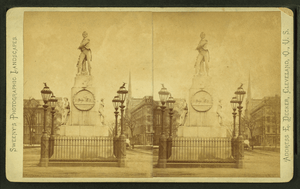Perry Monument (Cleveland) facts for kids

This picture from the 1870s shows the monument in its first home, Cleveland's Public Square.
|
|
| Coordinates | 41°30′09″N 81°41′53″W / 41.50255°N 81.69805°W |
|---|---|
| Location | Fort Huntington Park, Lakeside Ave. & W. 3rd St., Cleveland, Ohio |
| Designer | William Walcutt T. Jones & Sons (contractor) |
| Type | War monument |
| Material | Base & pedestal: granite Original statuary: white marble Replacement statuary: bronze |
| Height | Perry statue: 10 ft (3.0 m) Overall: 26 ft (7.9 m) |
| Completion date | 1860 |
| Dedicated to | Oliver Hazard Perry |
| Moved to its current spot in 1991. | |
The Commodore Oliver Hazard Perry Monument is a special war monument in Cleveland, Ohio. It honors Oliver Hazard Perry and his big win at the Battle of Lake Erie during the War of 1812. This monument was first put up in the middle of Cleveland's Public Square in 1860. The statue of Perry, made by sculptor William Walcutt, was the very first large sculpture in Ohio.
Over the years, the monument has moved several times around Cleveland. The original marble statues were replaced with bronze ones in 1929. The old marble statues were then stored and later given to the city of Perrysburg, Ohio, in 1937. In 1997, Perrysburg also replaced their marble statues with bronze copies. Since 2002, the original marble statue of Perry has been on loan to the Perry International Peace Monument in Put-in-Bay. The original marble statues of the Sailor Boy and Midshipman are now in the Perrysburg Municipal Building.
Contents
Perry's Big Victory
Commodore Oliver Hazard Perry led American forces to a major victory against the British Navy. This important battle, known as the Battle of Lake Erie, happened on September 10, 1813.
Building the Monument
In June 1857, the Cleveland City Council decided to build a monument for Commodore Oliver Perry. By October, a company called Thomas Jones & Sons Marble Works was chosen to build it. The plan was to raise $6,000 from Cleveland citizens to pay for the project.
Famous sculptors like Hiram Powers were asked to create the Perry statue. However, they felt the budget was too small. So, the builders turned to William Walcutt, a sculptor from Columbus, Ohio. Walcutt had studied art in London and Paris. He designed a new monument that the committee liked.
Walcutt's design included a large statue of Perry, bigger than life-size. It also featured two smaller sailor figures, called "Sailor Boy" and "Midshipman." The base of the monument had a round picture showing the battle.
Unveiling the Statue
The monument was officially shown to the public on September 10, 1860. This date was special because it was 47 years after the Battle of Lake Erie. More than 100,000 people came to see it! Important people like the governors of Ohio and Rhode Island (Perry's home state) gave speeches.
After the ceremony, a pretend battle was held on the water. The next day, a big military parade took place. Because of this important sculpture, Public Square became known as Monumental Park.
Moving the Monument Around
The monument has been moved many times:
- In 1878, it moved from the very center of Public Square to a different part of the square.
- In 1892, it was removed to make space for the Soldiers' and Sailors' Monument. It was stored for two years.
- In 1894, it was put back up in Wade Park, looking over Wade Lagoon.
- In 1913, it moved again to make way for the Cleveland Museum of Art. This time, it went to Gordon Park.
- By 1927, the marble statues were getting damaged by weather. A group called the Early Settlers Association raised $10,000 to replace them with bronze copies. These new bronze statues were shown in Gordon Park in 1929.
- The bronze statues moved within Gordon Park in 1951 and were stored in 1988.
- After being repaired, the bronze statues and monument were put up in their current spot in 1991. This is Fort Huntington Park, in downtown Cleveland.
The Sculptures
Walcutt's marble statue of Perry and the marble battle scene on the base were ready for the dedication in 1860. The two smaller figures, the midshipman and the sailor boy, were made in plaster first. It took more money to carve them in marble, which was finished in 1869.
Over time, the three marble statues and the marble battle scene were damaged by weather. In 1929, they were taken off the monument and replaced with bronze copies. These copies were made under the guidance of sculptor Herman Matzen. At the same time, a second bronze copy of the Perry statue was made for Rhode Island. It was placed at the Statehouse in Providence.
The original three marble statues and the marble battle scene were given to Perrysburg, Ohio, in 1929. They were put in Hood Park in 1937. In 1997, Perrysburg also replaced their marble statues with bronze copies. The marble sailor statues are now in Perrysburg's town building. The marble Perry statue has been on loan to the National Park Service since 2002. You can see it at the visitor center at Perry's Victory and International Peace Memorial in Put-in-Bay, Ohio.
A plaster version of the Perry statue, likely Walcutt's original model, is kept at the Western Reserve Historical Society in Cleveland.
You can even see Walcutt's Perry statue on the back of the 2013 "Perry's Victory" quarter!
Images for kids





